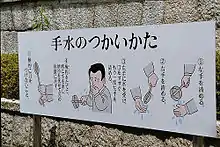Chōzuya
Chōzu-ya or temizu-ya (手水舎, ちょうずしゃ、てみずしゃ) is a Shinto water ablution pavilion for a ceremonial purification rite known as temizu or chōzu (手水, lit. 'hand-water'). The pavillion contains a large water-filled basin called a chōzubachi (手水鉢, lit. 'hand water basin').



At shrines, these chōzubachi, are used by worshippers for washing their left hands, right hands, mouth and finally the handle of the water ladle to purify themselves before approaching the main Shinto shrine or shaden (社殿). This symbolic purification is normal before worship and all manned shrines have this facility, as well as many Buddhist temples and some new religious houses of worship. The temizu-ya ("temizu-area") is usually an open area where clear water fills one or various stone basins. Dippers (hishaku) are usually placed in the area, and are available to worshippers. In the 1990s, water for temizu at shrines was sometimes from domestic wells, and sometimes from the municipal supply.[1]
Originally, this purification was done at a spring, stream or seashore and this is still considered the ideal. Worshippers at the Inner Shrine at Ise still use this traditional way of ablution.[2]
See also
- Ablution in Christianity
- Chōzubachi
- Glossary of Shinto
- Harae, a term for all Shinto purification rituals, including temizu
- Misogi, a Shinto ritual of full-body purification
- Ritual purification
- Wudhu
References
| Wikimedia Commons has media related to Chōzuya. |
- K Yokoi, R Nawata, S Furui, T Nagasawa, S Yanase, M Kimura, Y Itokawa (December 1991). 神社の手水の水質検査成績 [A Report on the Hygienic Status of Sacred "Temizu" Water in Shrines]. Nihon Eiseigaku Zasshi (in Japanese). 46 (5): 1009–13. doi:10.1265/jjh.46.1009. PMID 1779475.CS1 maint: multiple names: authors list (link)
- Mori Mizue. "Temizuya". Kokugakuin University. Retrieved 2020-05-28.
Further reading
- "chouzubachi" 手水鉢. Japanese Architecture and Art Net Users System. Atsumi International Scholarship Foundation. Retrieved 15 August 2016., and links therein
